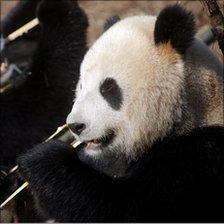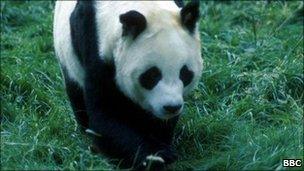Why do we love pandas?
- Published
For the first time in nearly two decades, two giant pandas will be brought from China to the UK, to live in Edinburgh Zoo. The project represents the culmination of five years of political and diplomatic negotiation at a high level. But why does the panda - unlike any other animal - have the power to involve and engage so much? And what is the key to its enduring popularity?
They remind us of ourselves

The panda's eating technique reminds us of our own
One of the main reasons we love pandas is that they remind us of ourselves, says Ron Swaisgood, Director of Applied Animal Ecology, San Diego Zoo Institue for Conservation Research, external.
"They eat sitting up using their hands and their special pseudo thumb, which is actually a modified wrist bone," he told the BBC News website.
Zoo visitors love to watch Pandas eating and are often amazed by the way they handle their food with considerable dexterity - thanks partly to that "pseudo thumb", which functions as a sixth digit.
The classic pose for a panda eating is one that resembles the way humans sit on the floor.
It's all in the eyes
According to Mr Swaisgood, we also love pandas because of their distinctive eyes. Their eye patches make their eyes look bigger.
"People love big eyes because it reminds them of children," he says. "This is called neoteny in scientific terms."
Neoteny basically means keeping a juvenile appearance into adulthood.
According to the San Diego Zoo's website: "Our own young have characteristics that we humans respond to such as a big, round head, large eyes, a high forehead, and a roly-poly body. We are programmed to respond to these babyish looks. Babies just make us like them and want to care for them. It is part of our human makeup."
In the human world, panda eyes can take on a less appealing connotation, often being associated with badly applied make-up, or lack of sleep.
They make us laugh
We just find pandas funny. But, according to Henry Nicholls, external, author of The Way of the Panda, they are undeserving of mockery. Indeed, pandas were not seen as figures of fun until humans failed to get them to reproduce in captivity.
Out of their natural habitat more than 60% of male pandas exhibit no sexual desire at all. In a bid to encourage them to mate, the Chinese have experimented with everything from what has been dubbed "panda porn" - explicit video of pandas mating - to traditional herbs.

After Chi Chi, people began to find pandas funny
In the 1960s, attempts to get Chi Chi, a famous panda bought by London Zoo, to breed failed spectacularly.
"At the height of the Cold War, she was even flown to Russia to mate with a giant panda there. It was a very high-profile failure, sparking a rash of cartoons about the case and an explosion of humour that has never gone away," Mr Nicholls told the BBC News website.
But in fact, pandas' mating habits are only funny by human standards, Mr Nicholls points out, and the species is very effective at breeding in the wild. The female panda may only be fertile for a few days each year but during this period she will mate dozens of times, with multiple males.
They are shy

Researchers go to great lengths to prevent panda cubs becoming familiar with the human form
The giant panda's enigmatic nature is in stark contrast to its sheer bulk and striking appearance. The few that remain in the wild are mainly scattered across six isolated mountain ranges across south-central China.
For researchers, it is a real challenge to find this extraordinarily elusive beast which moves away higher and deeper into the forest before long before humans can get anywhere near.
"There is some rather heartening that, in a very developed world, this species can still evade us and manage to carve out a space for itself," Mr Nicholls says.
They are cultural symbols
The panda has been relentlessly made into a symbol since the 1960s. It's been used by the WWF, external to convince us about the importance of conservation.
According to San Diego Zoo's Ron Swaisgood, the fact that they are an icon of conservation helps boosts their appeal.
"People love to rally around an underdog," he says. "Good news is, it's working. China has now established more than 60 reserves protecting the remaining pandas and researchers have accumulated enough knowledge about their biology and behaviour to have a self-sustaining captive population and begin to adaptively manage the wild population toward recovery."
The panda has also been used by China to represent the potency of a nation.

Giant panda cubs start off very small indeed
Our love of pandas has also been used as a marketing ploy - their black and white folds used to sell everything from sweets and fizzy pop to Western consumer to cigarettes in China.
The giant panda is so linked to the idea of China that, unlike any other animal, it has become a political symbol. Decisions to lend and loan pandas take years of negotiations. Edinburgh Zoo was reportedly in talks with the Chinese for half a decade before the deal to house Tian Tian and Yangguang was sealed. And, unlike the exchange of any other animal, these deals often involve political negotiations at the very highest levels.
They are rare
Giant Pandas are officially listed on the International Union for the Conservation of Nature's list, external of endangered species, which assumes there are fewer than 2,500 giant pandas in the world. The official figure is 1,596.
But, suggests Mr Nicholls, it is almost impossible to effectively document the actual number of pandas in existence, the animal is so elusive.
He says that such is the cultural and political power of the animal for China that is highly unlikely the number would ever be simply scientific.
"It has been suggested that with an animal this emblematic, politics gets in the way of the actual scientific decisions. A census which took place in the 1970s was highly massaged to get a sense of a species on the edge."
They are peaceful vegetarians
Although giant pandas are classified as a kind of meat-eater, in the wild they eat almost exclusively bamboo, and a lot of it. The average giant panda can consume as much as 14kg (30lbs) of bamboo shoots each day. Because of this simple diet, which is low in nutrients, the panda conserves energy by limiting its movements.
But the diet is also linked to some of the giant pandas most distinctive features, including its round face with its powerful jaw muscles to crush the shoots.
In captivity, pandas enjoy a much wider variety of foods - including honey, eggs, fish and fruit and vegetables like oranges, yams and bananas.